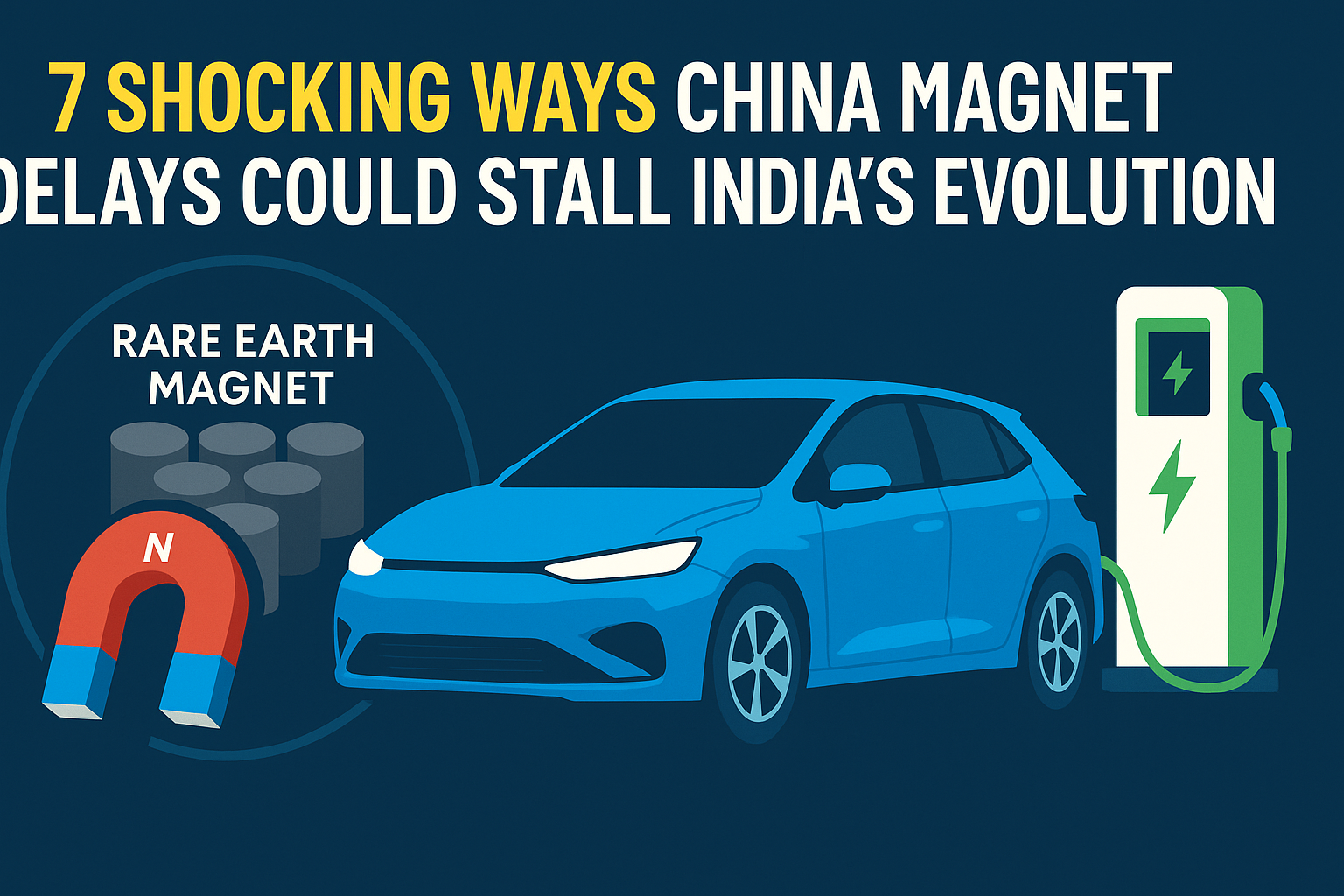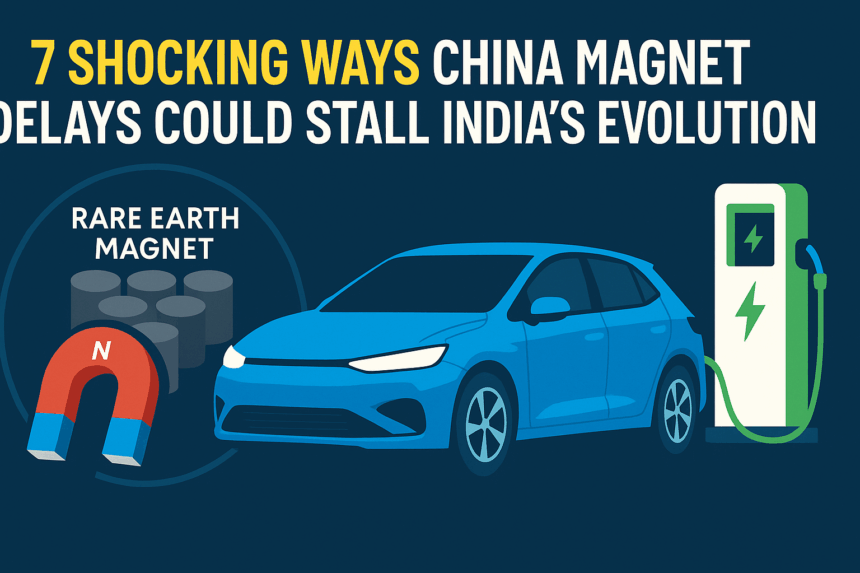
🚨 China Magnet Delays Threaten to Derail India’s EV Revolution
India’s electric vehicle (EV) ambitions are on the edge of an unprecedented supply chain cliff as China, the global powerhouse of rare earth magnet production, tightens its export restrictions. The term on everyone’s lips is now “China magnet delays”, which is far from a passing headline. For major Indian manufacturers like Bajaj Auto, these delays are more than just disruptions—they threaten to bring electric vehicle production to a complete standstill by July 2025.
Rare earth magnets, especially those made from neodymium and dysprosium, are essential for powering the motors inside electric vehicles. Without them, EVs can’t function—period. With over 90% of India’s rare earth magnet supply coming from China, any geopolitical or policy turbulence in Beijing sends immediate shockwaves through India’s EV ecosystem.
These China magnet delays have raised concerns across government, corporate boardrooms, and public infrastructure planners alike. If not mitigated swiftly, they could derail India’s entire green mobility strategy just as it’s beginning to gain momentum.
⚙️ Why Rare Earth Magnets Matter: The Backbone of Electric Vehicle Performance
China Magnet Delays Could Freeze EV Efficiency
Rare earth magnets are not optional in an EV—they are foundational. Particularly, neodymium-iron-boron (NdFeB) magnets offer unmatched torque-to-weight performance that no other commercial magnet can deliver. They serve several irreplaceable roles:
- Driving high-efficiency electric motors with minimal energy loss
- Enabling regenerative braking systems
- Providing better battery performance through energy conservation
- Allowing for smaller, lighter, and more powerful EV drivetrains
Without these components, EVs would need significantly larger motors and batteries, leading to higher costs, more weight, and less range. India’s manufacturers depend almost exclusively on Chinese imports to fulfill this magnet requirement. As China enforces stricter regulations on exports, these China magnet delays are increasingly leaving Indian manufacturers in limbo.
🌍 China’s Monopoly Over Rare Earth Magnets: The Root of the Delay Crisis
To understand the ripple effects of the current crisis, it’s important to first understand China’s strategic dominance in rare earth magnet production. While several countries possess rare earth reserves, China alone accounts for over 85% of the world’s rare earth magnet output. It also processes more than 90% of global REE (Rare Earth Elements) ores, giving it an iron grip over the supply chain from mine to motor.
In late 2023, China introduced new policies requiring exporters to obtain licenses to ship certain categories of rare earths, including neodymium-based products. This was done, according to Chinese officials, to better monitor strategic mineral flow and national interests. However, this has led to growing concerns worldwide that China may be weaponizing its rare earth dominance—and for India, this has led directly to the current China magnet delays that now threaten to stall EV production pipelines.
⏳ Bajaj Auto’s July Deadline: A Red Alert for Indian EV Manufacturers
In an alarming update to its investors and the government, Bajaj Auto announced that its electric vehicle production could hit a wall by July 2025 if supply issues from China are not resolved. According to the company’s internal forecasts, without fresh shipments of neodymium magnets, manufacturing lines may slow to a crawl or halt altogether.
This issue is not limited to Bajaj Auto. Other industry leaders—Tata Motors, Mahindra Electric, Ola Electric, and Hero MotoCorp—rely equally on China’s export pipeline for these rare earth materials. The situation places India in a fragile strategic position, exposing the country’s over-dependence on external sources for critical components at a time when domestic EV adoption is being aggressively pushed by the government.
The broader implication? If China magnet delays continue unabated, India may miss key milestones on its National Electric Mobility Mission Plan (NEMMP), falling behind on both domestic targets and international climate commitments.
📉 7 Catastrophic Impacts of China Magnet Delays on India’s EV Industry
As the supply chain bottleneck tightens, here are the seven most serious consequences that India faces from prolonged China magnet delays:
- Production Halts Across the EV Sector
Major automakers could halt or scale down EV output due to raw material shortages. - Inflated EV Prices for Consumers
Magnet scarcity will drive up prices, making EVs less affordable to India’s middle class. - Delayed Vehicle Launches
Upcoming models scheduled for release in 2025 and 2026 may face indefinite delays. - Layoffs in Manufacturing Hubs
With plant activity scaling down, thousands of workers in states like Maharashtra, Tamil Nadu, and Gujarat could face temporary unemployment. - Decline in Foreign Investment
FDI in India’s clean mobility sector could taper off due to fears of supply instability. - Stagnation in Infrastructure Development
Slowed EV adoption will impact related industries like charging infrastructure, battery swapping, and smart mobility startups. - National Climate Goals Under Threat
India’s pledge to electrify 30% of its fleet by 2030 may be out of reach if the China dependency is not resolved.
These impacts illustrate how a simple trade delay has morphed into a nationwide crisis, endangering India’s economic, environmental, and strategic interests.
📢 SIAM’s Recommendations: Urgent National Action Needed
The Society of Indian Automobile Manufacturers (SIAM) has issued a formal appeal to the Government of India, highlighting the urgent need for policy intervention. Their key recommendations include:
- Diversifying magnet imports to include countries like Australia, Vietnam, and the U.S.
- Reducing customs bottlenecks by introducing green-channel clearance for rare earth imports
- Providing incentives for local magnet production and rare earth recycling
- Establishing strategic mineral reserves akin to India’s petroleum reserve model
SIAM has made it clear that China magnet delays are no longer a corporate issue—they are a national concern requiring multi-ministerial coordination, involving the Ministries of Commerce, Mines, Environment, and Heavy Industries.
🏗️ India’s Import Bottleneck: Bureaucracy Slows the Flow
Even when rare earth magnets are available from global suppliers, India’s complex import ecosystem acts as another barrier. The key challenges include:
- Multiple tiers of paperwork for customs and environmental compliance
- Delays in port inspections due to hazardous material handling rules
- A lack of real-time tracking for inbound shipments
- Limited testing facilities to verify magnet quality and safety standards
These administrative inefficiencies mean that even available shipments from China are delayed by weeks or even months. In a fast-moving sector like EVs, this timeline is enough to disrupt entire production calendars.
📚 Industry Reports Reveal India’s 90% Dependency on Chinese Magnets
A 2024 whitepaper from India’s Ministry of Commerce confirmed that over 90% of all rare earth magnets used in domestic EV manufacturing are imported from China. The paper also revealed the following:
- Only three small-scale pilot plants exist for magnet recycling
- No significant commercial projects are underway for rare earth processing
- Domestic magnet manufacturing currently meets less than 5% of national demand
These statistics make it abundantly clear: India is dangerously exposed, and without a coordinated response, China magnet delays will continue to cripple its EV strategy.
🛑 Beyond Trade: China Magnet Delays as Strategic Leverage
China has used its control over rare earths as leverage in past global disputes—including tensions with the U.S. and Japan. Analysts now believe that China’s latest export controls may be part of a broader strategy to exercise soft power through strategic resources.
By dominating rare earth exports, China indirectly influences downstream industries globally—from EVs to smartphones and defense equipment. For India, this poses a unique challenge as it seeks to both electrify transportation and reduce reliance on foreign technology.
In this context, China magnet delays represent more than supply disruption. They are a strategic chokehold.
🛠️ A 3-Tiered Strategy: How India Can Tackle the Magnet Crisis
Here’s a practical roadmap for India to protect its EV ambitions against future supply shocks:
🔹 Short-Term (0–12 months)
- Ramp up magnet imports from trusted allies like Australia, Malaysia, and Canada
- Create special economic zones for rare earth imports with fast-track customs
- Allocate emergency budgets to key OEMs for supply stabilization
🔸 Medium-Term (1–3 years)
- Support the development of rare earth processing units under the “Make in India” initiative
- Build partnerships with Quad countries for technology sharing
- Incentivize public-private R&D collaborations in magnet alternatives (e.g., ferrite magnets)
🌱 Long-Term (3–10 years)
- Launch rare earth mining operations in Odisha, Andhra Pradesh, and Rajasthan
- Create a Magnet Innovation Hub to support startups working on EV motor tech
- Form a National Rare Earth Council to oversee strategic reserves, pricing, and geopolitics
🔚 Final Thoughts: A Critical Crossroads for Indian EV Aspirations
The current crisis caused by China magnet delays is not merely a momentary disruption—it’s a strategic wake-up call. As the world moves toward decarbonization, controlling resources like rare earth magnets will be as important as controlling oil in the last century.
India has the technological capacity, the market demand, and the policy will. What it now needs is the strategic vision and coordinated action to free itself from this unsustainable dependency.
If India can respond decisively, it won’t just overcome the current magnet crisis—it will emerge as a resilient global leader in the EV landscape.
External Sources:
- Learn more about NdFeB magnets and their role in EV technology (Source: ScienceDirect).
- China tightens rare earth exports (Source: Reuters)
- SIAM urges Govt. to act on rare earth shortage (Source: Economic Times).
Follow StellarBulletin for more such news..


